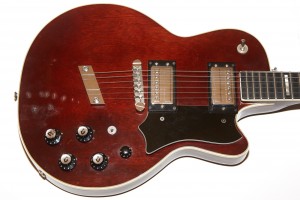
In honor of this guitars long and less-than-pristene past, I opted to photograph it right as it came from the box in all its dusty, dirty, and finish-marred glory. Let’s see how it fares given my normal desire for bright and shiny instruments.
Introduction
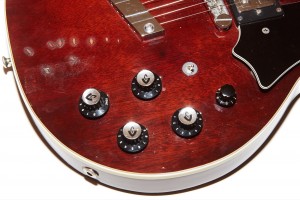
These 1974 Guilds have two Guild HB1 pickups that I’ll cover later in this article, a master volume which is great, even if it is in a bit of an odd position, a phase switch, and a neck that’s too damn small for my big hands. And yet, I can’t put the freakin’ thing down because it just sounds so good!
As soon as I strap this guitar on I feel like the guy in the ad to the right. I’ve owned a lot of Guilds, but there’s something special about the M-75. It’s light, it’s resonant, it’s just the right size, it sounds amazing, and I feel like a rock star when I play it. Sure, I feel like a long-haired high-school rock star from 1979, but dammit, I was a long-haired high-school rock star in 1979! This guitar just reinforces the memories.
I’ve long opined that the reason Guild electric guitars aren’t more famous or desirable is because Jimmy Page didn’t play one. That may be true, and it may also be a saving grace since they don’t sell for crazy “Jimmy Page played one” prices. Hell, if they did then I wouldn’t be able to write all these articles about them.
Finish
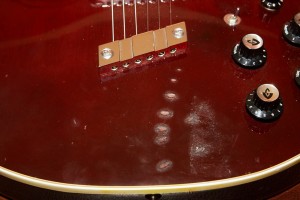
See that series of terrible melted spots on the finish? Those are the result of someone laying one of those fabulous (cheap) vinyl coiled cords that we all used in the 1970s on top of the guitar and then probably closing it all up in the case. The vinyl on in the cheap cord reacted with the lacquer and melted it down to the wood. If you zoom into the pic you can even see the pattern from the ribbed cable in the finish.
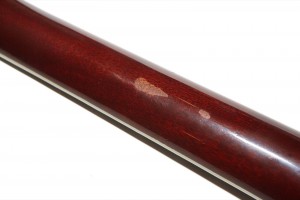
Keep vinyl away from your lacquered guitars, kids. That includes anything that even looks like bubble wrap.
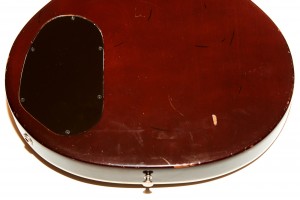
Fretboard and Neck
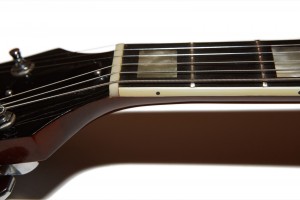
Take a quick look at the pic of the neck to the right. The fretboard is bound, but the binding is pretty thin compared to just about every other bound guitar I’ve played. The fret markers are also fairly small, though they work as intended.
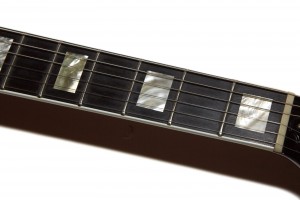
The frets are a bit small at 3/64″ tall by 5/64″ wide which is typical of this era of Guild electric guitars. The neck attaches to the body at the 18th fret and the fretboard radius measures at 16″ which seems about the norm for Guild electrics of this era. It really is a beautifully done fretboard and neck, especially if you like smaller examples.
Build Quality
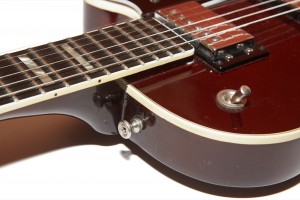
There are no obvious shortcomings of the design of the guitar, though some might complain about the upper strap button being too close to the neck which makes some straps rub up against the neck thus causing wear. There is a noticable lack of such wear on this guitar making me wonder if the guy who put it in the case with the coiley cord was so despondent that he just closed up the case and left it alone. For years.
The pick guard is an odd affair that is screwed right into the top in multiple spots making it a bit ugly to remove. Thankfully, it doesn’t get in my way when playing so I just left it as-is. Thankfully, Guild hadn’t included logos on pick guards in this series of guitars, at least in this year’s model, so I don’t have any other reason to remove the guard.
If you told me that this guitar was chambered I would believe you, but without the proper name plate (see the Electronics section below) I don’t know if the model number suffix -CS (solid body with chrome) is included. The guitar weighs in at 8 pounds on the nose and the pics of the electronics later on doesn’t show any chambers so I’m going with solid.
Pickups
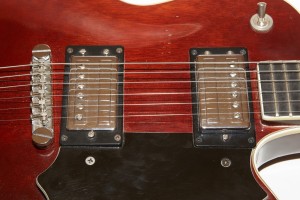
These are low-wind pickups measuring around 7k Ω and 7.3k Ω and have all the chime, articulation, and character that Guild HB-1s are known for. They are very PAF-like with a bit of extra chime where it counts.
Electronics

This guitar has the typical 4-knob control scheme, but also includes a master volume near those controls. I love master volume controls on guitars and wish that more models had them, but I’m not a huge fan of the smaller knobs that Guild used on their master volumes. Given the location they chose on these guitars, though, a smaller knob actually sort of makes sense.
As an odd bit of mystery, this guitar came with a control plate cover that doesn’t belong to the guitar. The serial number for the guitar is written on a sticker on the control plate cover and it doesn’t match the one on the headstock. Not only that, but the model number has a -BLK suffix indicating a black finish which this guitar quite obviously does not have.
The electronics cavity is completely lined with copper as are all the Guild electric guitars I’ve seen from the ’70s. The wiring is clean and while it certainly could be neater, that’s really just my inner soldering nerd lashing out.
The guitar has a master volume and a phase switch which makes the wiring a bit more complicated than a typical two humbucker guitar, so the extra wiring can excuse the little bit of mess. Besides, it still looks better than the wiring I’ve seen in most of the guitars from the past 20 years, imports and domestics alike.
Hardware
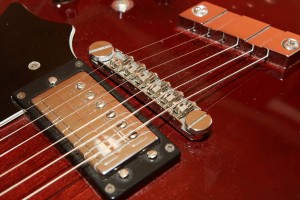
The bridge is a Mueller type bridge popular on Guild electric guitars in the 1970s. I personally love these bridges, though they can be problematic if you break one of the tiny parts as the parts can be very difficult to find. I had a Guild S300A-D for thirty years with the same bridge that I played every damn day and I never broke or lost any parts.
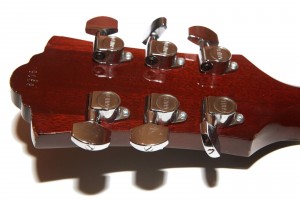
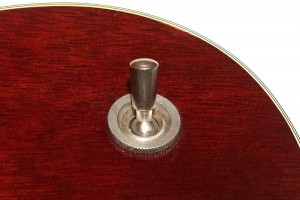
Sound
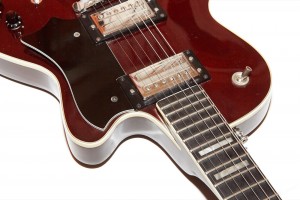
Basic 800
Chords
Open E chord
12th Fret
For each recording, I cycle through all of the possible pickup combinations, those being (in order): neck pickup, both pickups (in phase), both pickups (out of phase), bridge pickup. Trust me when I that if you get tired of hearing the same riffs over and over, that can’t possibly compare with how much I hate hearing them after playing them 140 times and testing and editing the sound files for hours. Yikes.
Tiny Tweed
Chords
Open E
12th Fret
I really did not find any of the tones to be unwelcome. On my Guild S300A-D that I had for decades, I never used the phase switch because I thought it sounded terrible, but that guitar had Dimarzio pickups in it which I think may have been the problem. On the M-75 with its HB-1 pickups, I think the out-of-phase sound is quite usable depending on the amp in use.
In my opinion, it’s damn-near impossible to make a bad tone come out of this guitar. I’m sure I could hand it to a random kid in Guitar Center who could prove me wrong, but that’s a topic for another time.
Playability
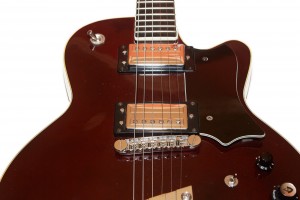
One of the things I like about the Mueller bridge is the fact that it’s simple to adjust string spacing, though the neck is so thin that pulling the strings even further together reduces playability for me, so I just alter my technique in order to adjust to the smaller fretboard. In fact, this is one of the few guitars that makes me forget about the small fretboard. It’s just that good.
This guitar is very thin, and that makes an absolute joy to play. I have a lot of electrics, and this one, though not as thin as a Gibson SG or Guild S-100, is pretty close. Imagine a Les Paul but thinner and that’s what you get with this guitar. It’s very comfortable to play both sitting and standing and I swear that while standing I don’t even notice it’s there. You know, except for the fact that I’m holding it with both hands.
Conclusion
I scored this guitar for half of what they usually go for, all due to the terrible finish blemish on the top. This guitar is a robust, great-sounding instrument, and if you like thinner necks, you’ll fall in love with a Guild M-75 instantly. The problem is that they usually sell for big money, so you might have to settle for a beater if you don’t want to spend your precious shekels in Les Paul quantities.
Honestly, and this is complete opinion on my part, this guitar sounds better than even the Gibson Les Paul Historics I’ve owned (two R9s and one R8). If only it had a beefier neck, then I would say that it crushes them utterly, but the truth is that I enjoy the fat necks on the Les Paul Historics. I just don’t enjoy them enough to pay the ridiculous sums of money that they command.
Bottom line: If you see a Guild M75 and you can afford it, buy it, especially if you like smaller necks. Hell, if it’s anything like this one, but it anyway and learn to adapt. It’s that good.
Donate: PayPal Crypto:
ETH: 0x0AC57f8e0A49dc06Ed4f7926d169342ec4FCd461
Doge: DFWpLqMr6QF67t4wRzvTtNd8UDwjGTQBGs

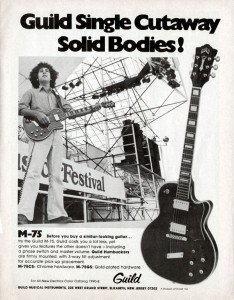
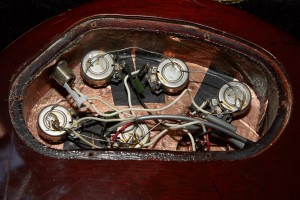
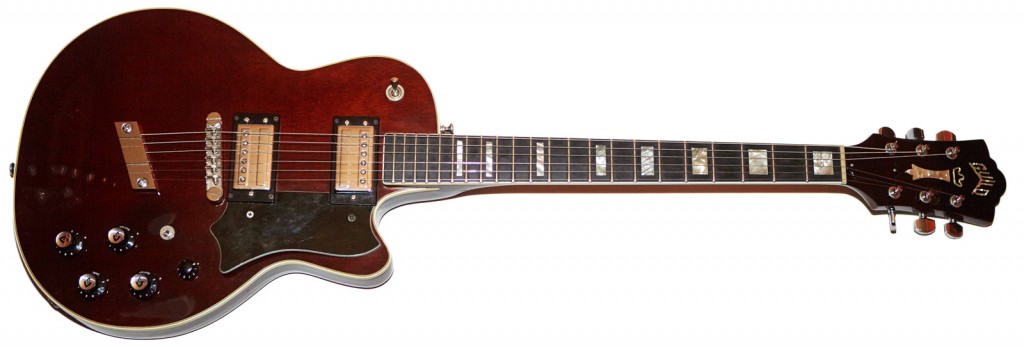
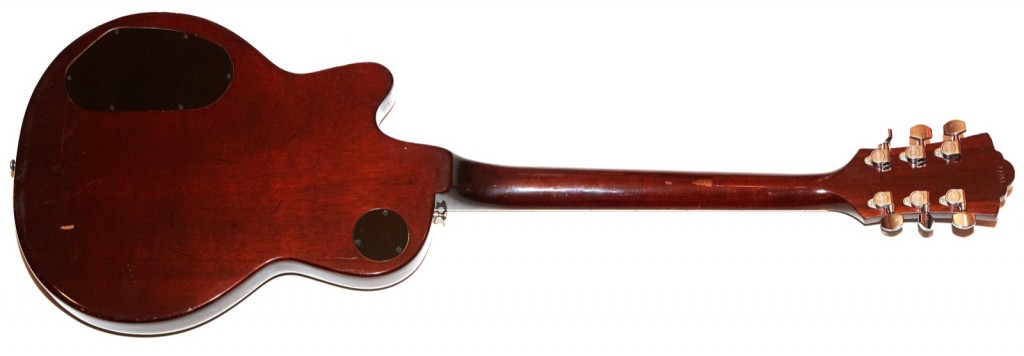
I have a 1974 blues bird M-75 with natual mahogany top, it seem to be in very good shape except for what looks like stress cracks on the top, I don’t think the switch tops and knobs are original, but it plays and sound great, I enjoyed your opinions on the guitar
Hi there Gary.
I happen to own the exact guitar you are describing so eloquently and I agree with your evaluation. I lived in London where I worked as a graphic designer and had also a rock band. I bought it in the mid seventies for peanuts from a friend’s music shop not thinking much of it and ended up using it more than my Les Paul Custom, Strat, Les Paul Special, SG Les Paul junior etc. etc.
I have been living in Cyprus for the last 35 years where I also played in a rock band in a night club and again I always used this guitar. Is in mint condition and the only damage that occurred was that the binding on the neck started falling off bit by bit. I think it was due to the fact that the case was not a proper one for this guitar, it fitted in too tightly plus the extreme weather changes of the island certainly played a role.
I took it to the best Luthier in Cyprus who used to live in the UK too, and he fixed it perfectly doing some minor dressing to the frets and every note rings perfectly now. He told me spontaneously that this is a great guitar, and even if he himself offered me 3000 euros on the spot, I shouldn’t sell it!!!!! I have been using it lately to record on THE GARAGE BAND software and indeed this guitar is capable of being played in any style!!!!!
I have a sunburst Guild M75. It is almost identical to the one in this article except it has a different style pick guard. The guard is more rounded in the cutaway area & a soft round edge instead of the ‘flair’ point next to the control area. What is the difference between an M75 & a Bluesbird?
sorry, sent old email. Please use mtopenrange@gmail.com
I should have mentioned that I acquired this M75 about 15-20 yrs ago from a friend who had it stored under some construction tools, ladders & such, in the back of his work van out here in Montana. I think it may be mid 70’s w/serial # 91322 but don’t know for sure.
I’ll try this again, my first comment disappeared. About 15-20 yrs ago I acquired a Guild guitar from a friend who had been storing it in his work van under some ladders & construction tools. The case was pretty beat up as well as the guitar; some deep rub marks and scratches down to the bare wood but still playable. I paid him $50 and brought it home. It is very much the same guitar as in this article except the pick guard has a more rounded tip in the cutaway area and has more of a soft rounded edge instead of the flair point, next to the elec. control area. The neck plays well, pups sound good etc. What is the difference between an M75 and a Bluesbird? Great article, thanks for info.
Your comments are not disappearing – they must be approved by me to cut down on spam.
If you’d like a comparison of Bluesbirds, check out either of these posts:
https://www.gad.net/Blog/2017/01/27/guild-bluesbird-bake-off/
https://www.gad.net/Blog/2016/07/17/1997-guild-bluesbird-guitar/
Guild used the term “Bluesbird” for anything even remotely Les-Paul shaped. They also put names and numbers together frequently, so yours is likely an M-75 Bluesbird. In other words, it’s both.
Also, I *highly* recommend you get a copy of Hans Moust’s book, The Guild Guitar Book (https://www.amazon.com/Guild-Guitar-Book-Hans-Moust/dp/0634009664)
It’s out of print right now, but you can probably find one on eBay. Also you could email Hans through his website: https://www.guitarchives.nl/guitarsgalore/
. When it comes to Guilds, Hans knows all.
I have this guitar too. My uncle bought it with me in a guitar store in my town in Ecuador in south america. The guitar was in pretty bad shape. It had holes in the wood near the jack and the other one a crack near the volume/tone pots. It had no binding in the left side of the neck. My uncle had a Guild s-100 and he always wanted the “les paul” take that Guild offered from those years. Unfortunately, my uncle got sick and died so he was not able to restore the guitar. I took the guitar and fixed all the wood problems it had with a luthier in my town who happen to be a magician. He also built the binding for the neck that was missing, and replaced a missing inlay.
When the luthier fixed all the wood problems I realized that the bridge was kind of weird to me and if I hit the string hard the low E used to come out of the bridge a lot so I replaced it with a Gibson AB bridge. The pups were Ok but I never bonded with them. I see you compare the guitar with your les pauls but I have an R0 and they have nothing to do with each other IMO. Maybe the pups weren’t at their 100% either so I have to give you the benefit of the doubt. I swapped the original pups for a set of lollar imperial pickups. I still keep the original parts just in case but I’m happy to have the guitar playable to my taste.
And YES the neck is narrow and thin, maybe the smallest neck I’ve ever played. I like thin necks but this one feels really thin! but as you wrote before after 15 or 20 minutes you can adjust yourself to the guitar and this can have a lot of advantages. I play Blues, rock and jazz and for straight ahead jazz this is a really confortable guitar and sounds better than all my semi hollow which I end up selling after having this guitar (even a heritage 335 style). This guitar has a woody tone that is perfect for the styly and playing fast with much less effort. I have also gigged a lot playing rock and blues with this one but now I honestly prefer my R0 or a strat for this styles mainly because of the neck feel specially when i’m bending strings a lot. It’s not that the guitar is not capable tonewise but its just a playability thing for me, this guitar could still get me there.
About comparing it with a les paul: IMO they are different animals, they could get you to the les paul territory but I see this guitar more as and hybrid between a les paul and a Es335 with some Guild special sauce. When you are playing big venues or cranking up an amp during recordings you realize that a Les Paul being a solid body can have more presence and a little bit more bite with distortions, not that M-75 falls THAT short in this matter but there’s a difference, you can also note that I don’t use the real pups and bridge so there might be a difference but that’s how I feel about this.
Anyway this is my take on this great guitar and I concur with the OP, If someone has the chance of buying this do it, this is an unique instrument.
Best,
JMH
Fabulous response! Thanks for sharing!
Thank you! Great review!
Best,
JMH
I have one I’ll sell for $800
I have inherited what looks like this same guitar, by serial number, also 1974. However, the apparent model number written on the inside of the back cover says “M45” not M75 (M 45 CU AL, I think, it’s handwritten).
Any guidence you can give would be appreciated, my guitar teacher essentially willed it to me and I want to give his widow appropriate compensation. Thank you.
To the best of my knowledge Guild never made an M45. If you send me pics of the guitar and the label I can tell you more. I can also tell you that some of the hand-written labels had some pretty messy handwriting.
Guild Bluesbirds are indeed beautiful guitars. I have owned a number of them. The reason why they did not catch on had nothing to do with Jimmy Page not playing one. For the right application, Bluesbirds are great guitars. However, their extreme chambering gives them a rather scooped sound: that is, lacking in midrange, specifically lower midrange. It is exactly this richness of midrange that has made Les Pauls and ES-335s popular. And try to think of really well-known, great players who have played Bluesbirds extensively; players known for their tone. You can’t. Sure, John Fogerty played one a lot back around 1970s, and it worked fine for what he does. But does he ever still play one? No. Buddy Guy had a Bluesbird back in his Guild era, but he never played it (I lived in Chicago and went to see him regularly). Instead he played his Guild Starfire semi-hollow. Larry Carlton did one song on one record with the Bluesbird; and that song is not known for its great guitar tone. Robben Ford played the Bluesbird very shortly and did not continue. He did play guitars similiar in construction to the Bluesbird for about 5-6 years during his Blue Line period, but he tended to use a more processed lead guitar back then. Nor does he play anything like that now. Bluesbirds are gorgeous and sound nice, but kind of thin-sounding. If that works for you, then they are great guitars. RJ Ronquillio has a really nice video on YouTube playing a newer Bluesbird (which has the same construction as the older ones) and he sounds great, but he is letting the guitar do what it can do well. Others with more specific needs may or may not like the sound of a Bluesbird.